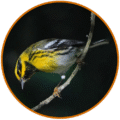
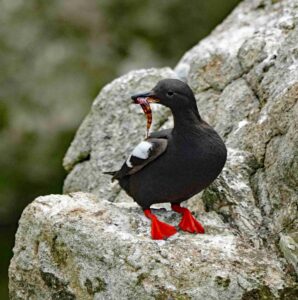

As we approached aboard the Salty Lady, the Farallon Islands rose like ghosts out of the Pacific: jagged, fog-bound sentinels. Their granite flanks were streaked white with guano, and the wind carried the sharp cry of seabirds over the swell. With no dock or landing beach, we loaded onto a small skiff and were hoisted by a crane, boat and all—dozens of feet above the crashing surf—into a moonscape of sharp rock.
On these islands some 30 miles west of San Francisco, there are no trees, no freshwater streams, just bare stone and the relentless roar of waves. And yet, in this stark cathedral of sea and sky, life pulses.
Every year, more than half a million seabirds descend on the islands to breed – the largest seabird colony in the contiguous United States. Common Murres crowd the cliffs like dominoes. Tufted Puffins dig burrows among the stones. Western Gulls guard their nests with raucous squawks. These birds, and the fragile ecosystem they inhabit, are at the heart of a decades-long partnership between Point Blue Conservation Science and the U.S. Fish and Wildlife Service (one that is imperiled now, as funding becomes tenuous).
Since the late 1960s, a rotating team of researchers has lived year-round on the islands, monitoring bird populations, marine mammals, and ocean conditions. Like us, they arrive by boat and are lifted by crane, with all their gear, atop the cliffs. Here, they live in old lighthouse keepers’ quarters and fall asleep to the sound of gulls calling from the roof above their heads. Their work is steady and painstaking. Apprentices scramble over rock faces to count eggs, band chicks, and gently net seabirds in the night as they arrive home from long oceanic fishing trips. The island scientists log their data every day of the year, taking notes as fog drips from their hoods. From this intimate work arises a vast view.
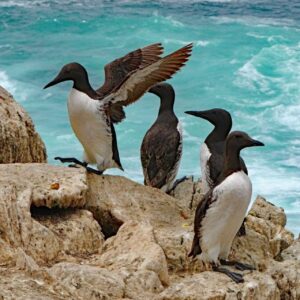
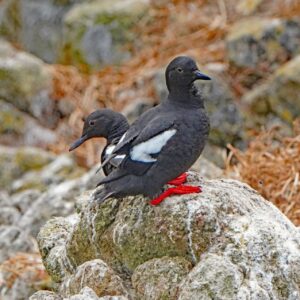
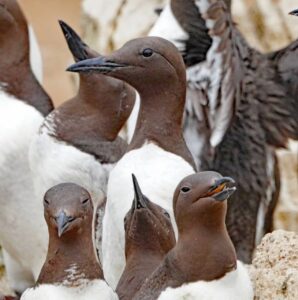
“Seabirds in particular are amazing indicators of what’s going on in the marine environment,” says Pete Warzybok, Farallon Program Leader. “They’re reacting to physical changes – upwelling, ocean patterns, storm event, chemical changes like acidification, biological changes like food availability. They’re very quick to respond to these changes – sometimes within a week – we can learn a lot about the large ecosystem by studying the birds.”
In many ways, the islands are like a barometer: what happens here, among the birds, allows us to forecast what pressures may affect the broader region. When Common Murre populations dip, it may signify an anchovy shortage along the California coast, perhaps driven by warming waters and shifts in upwelling patterns. When Cassin’s Auklets die of heat stroke in their rocky burrows, it’s an indicator of a warming climate (now, Point Blue has begun providing cooling ceramic nesting boxes to help protect these vulnerable little birds).
“Everything affects everything else on the islands,” says Gerry McChesney,
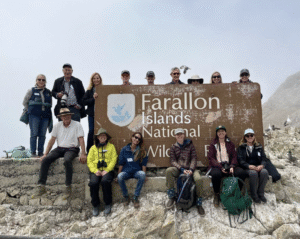
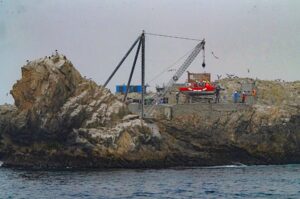
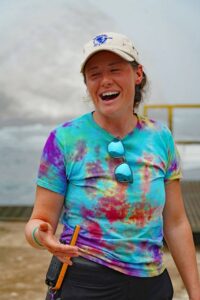
Manager of the Farallon Islands National Wildlife Refuge. By extension, everything that happens on the islands is inextricably connected to the surrounding sea that we all share.
That web of connection extends far beyond birds. The Farallones are also home to five species of seals and sea lions, which haul out on the rocks to rest and breed. Their movements reflect shifts in ocean health and prey availability. The “poster pinniped” of the islands is the Northern fur seal, once numbering in the hundreds of thousands, driven to local extinction by fur hunters in the 1830s. But in the 1990s, researchers from Point Blue began spotting the first tentative signs of a comeback: a lone male hauling out on the island’s western edge, then a pair, and then, in 1996, something extraordinary: a pup! Since then, fur seals have steadily reclaimed their ancestral breeding grounds, with the number of pups born reaching over 2000 annually. The comeback is one of the island’s most powerful ecological stories, and Point Blue has documented it from the start.
A long view of the data shows that it’s all connected: fur seal populations, sea bird survival, oceanographic trends, fisheries health—and, too, the many extractive ways humans have used the islands across the decades.

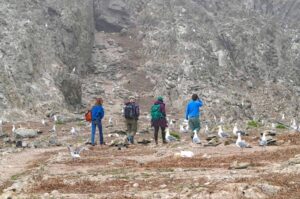
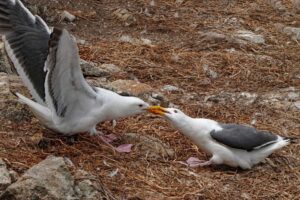
The data from the Farallon Islands serves as a cautionary tale for damages from the past, and as an early warning system for imbalances in a changing sea. But the data also offers continuity and hope. The long-term monitoring program run by Point Blue, one of the most comprehensive of its kind, helps scientists connect the dots between ocean temperature, fish stocks, bird behavior, and climate shifts across the Pacific Rim. The connective science on the Farallones has helped drive policy decisions, including a 1994 ban on gillnetting and the establishment of a Marine Protected Area around the islands in 2010. It’s become a model for how local, place-based science can inform global understanding.
And still the birds return – even after near-decimation by egg-hunters in the 1800s, after nuclear waste dumping, overfishing, and the churning gears of climate. On our summer visit, the cliffs were alive with ruffling wings and crying gulls. Pigeon Guillemots whirred past, their red feet splayed out behind. On a lichen-covered ledge, we set down our binoculars and watched the fog unfurl across the islands, thick and silver.
Out here where the continent falls away, the Farallon Islands remain both refuge and revelation: an outpost where the natural world speaks clearly, if we practice the patience of attention.
